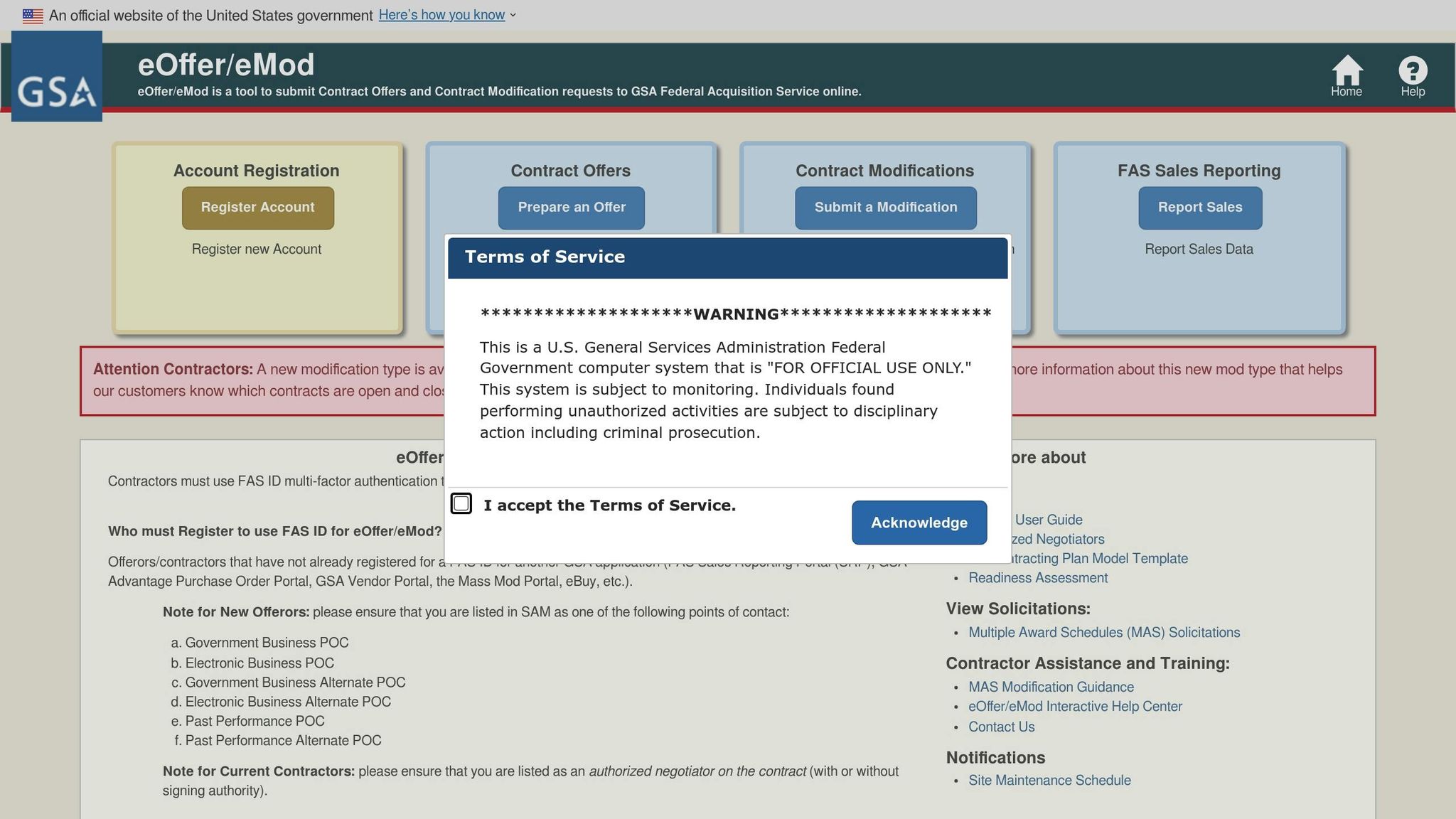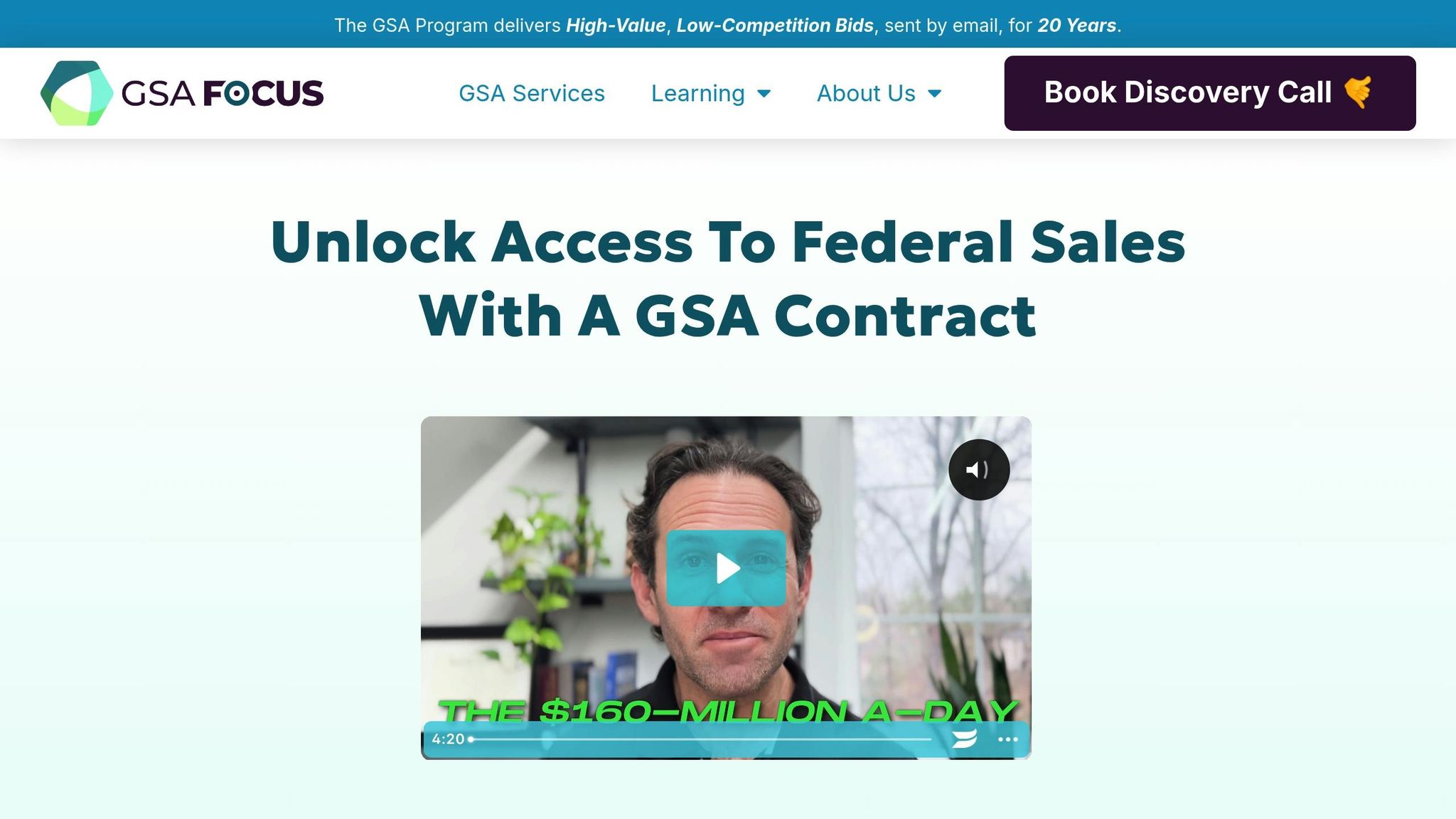Submitting a GSA proposal can help your business access over $40 billion in federal contracts annually. Only 4% of small businesses hold GSA Schedules, making this a largely untapped opportunity. Here’s how you can get started:
- Prepare Your Documents: Gather essential paperwork, including business registration, financial records, past performance narratives, pricing data, and compliance certifications.
- Set Up GSA eOffer Access: Obtain a digital certificate (cost: $100–$150/year) and create a FAS ID account to access the secure platform.
- Submit Your Proposal: Upload your documents, ensure NAICS/SIN codes align with your business, and verify everything using the GSA checklist.
- Respond to GSA Follow-Ups: Be ready to address questions or negotiate terms to finalize your contract.
Proper preparation and attention to detail are key to avoiding delays and securing a long-term government contract. These contracts can provide predictable revenue and enhance your business’s credibility. Ready to begin? Let’s break it down step-by-step.
GSA Schedule – Part 2 of 3: Getting Onto The GSA Schedule Proposal Prep
Preparing Your GSA Proposal Documents
Before diving into the GSA eOffer platform, it’s crucial to gather all the necessary paperwork. The process can be time-intensive, with businesses often spending over 100 hours on GSA-related documentation. Thorough preparation not only saves time but also ensures a smoother submission process. Start by understanding exactly what documents you’ll need to build a strong proposal.
Required Documents and Information
A successful GSA proposal hinges on providing a comprehensive set of documents that highlight your business’s qualifications, stability, and ability to meet federal contracting requirements.
- Business Registration and Legal Documents: Make sure your business is registered and active on SAM.gov. You’ll also need a current DUNS or UEI number linked to your business, along with your business license, articles of incorporation, and any other relevant certifications.
- Financial Documentation: Demonstrate your financial stability with records such as audited financial statements from the past three years, tax returns, bank statements, and a current balance sheet. If your business is newer, alternative documents like bonding capacity or credit lines may be required.
- Technical and Past Performance Narratives: Showcase your expertise and experience by including detailed descriptions of similar projects, measurable outcomes, and client testimonials. Don’t forget to provide contact details for references who can vouch for your past performance.
- Pricing Data and Commercial Sales Practices: Submit your commercial price list, discount schedules, and sales data. This information helps GSA assess and negotiate fair pricing for government contracts.
- NAICS Codes and Special Item Numbers (SINs): Accurately match your business’s NAICS codes with the SINs you’re targeting. Misalignment here can lead to delays or even rejection of your proposal.
- Compliance Certifications and Representations: Gather certifications that confirm your adherence to federal requirements, such as small business status, labor standards, or environmental regulations. The exact certifications needed will depend on your business type and the SINs you’re pursuing.
Using the GSA Offer Submission Checklist
Once your documents are ready, use the official GSA Offer Submission Checklist to ensure everything is in order. This checklist is an invaluable tool for catching any missing pieces or errors that could slow down the review process.
Since GSA regulations change frequently, always work with the most recent version of the checklist. Pay close attention to document formatting and organization, as specified by GSA guidelines.
To stay organized, consider creating a master folder with subfolders for each document category. Clearly label each file according to GSA’s requirements. This system not only helps you keep track of your submission but also allows you to respond quickly if GSA requests additional information. A well-organized submission can make all the difference in avoiding unnecessary delays.
Setting Up Access to the GSA eOffer Platform

With all your documents prepared, the next step is to set up access to the GSA eOffer platform, the secure system for submitting your federal contract proposal. This platform ensures the security and integrity of submissions by requiring specific credentials, including digital certificates, before you can proceed.
Getting a Digital Certificate
A digital certificate acts as your electronic signature and is essential for accessing the GSA eOffer system. It serves two purposes: verifying your identity and securing your submissions.
To obtain a digital certificate, you’ll need to purchase one from a GSA-approved certificate authority, such as IdenTrust or Entrust. The process involves submitting identification documents, completing an application, and installing the certificate on your computer. The GSA website provides a list of approved vendors and detailed instructions to guide you through the application process.
The cost for a digital certificate typically ranges between $100 and $150 per year. While this is an added expense, it’s a necessary step for secure federal contracting and can be used for multiple submissions during its validity period, making it worthwhile for businesses pursuing several GSA opportunities.
Most vendors offer clear installation guides, but the general process involves downloading the certificate file and importing it into your browser. To avoid last-minute issues, test the installation before attempting to access the eOffer platform.
Creating Your FAS ID Account
A FAS ID account serves as a single sign-on credential for accessing GSA systems, including eOffer. To set one up, visit the GSA FAS ID registration page, provide your business email address, enable multi-factor authentication, and verify your identity. Once registered, you’ll use your FAS ID credentials to log in to the eOffer platform.
During registration, you’ll need to use the same business email and personal details tied to your SAM.gov registration. Multi-factor authentication will require a mobile device for verification. Additionally, you’ll be asked to confirm your role in the company and your authority to submit proposals. Ensure this information matches your SAM.gov records to avoid delays in gaining access.
Keep your FAS ID credentials secure. If others in your organization need access to eOffer, they must create their own FAS ID accounts with the necessary permissions.
Once your FAS ID account is active, you’ll be ready to explore the eOffer platform.
Navigating the eOffer Platform
The eOffer platform is organized into key sections that guide you through the submission process. The dashboard displays your active submissions and their status. The document upload section allows you to attach required files, while the forms section includes fields for pricing details, technical data, and certifications. Built-in validation checks help identify missing or incorrectly formatted information before submission.
Pay close attention to these warnings, as they can save you from having to resubmit corrected documents later. You can also save your progress and return to it at any time.
One critical feature is the digital signature capability. Use your installed digital certificate to sign your submission. This signature legally binds your proposal and requires a valid, properly installed certificate.
For additional support, consult the help section, which includes tutorials and troubleshooting guides. Familiarizing yourself with these resources can help you avoid technical hiccups that might delay your submission.
| Step | Requirement/Action | Notes |
|---|---|---|
| Obtain Digital Certificate | Purchase from GSA-approved vendor | Required for secure access and signatures |
| Register FAS ID | Create account, enable multi-factor authentication | Used for eOffer login |
| Confirm SAM.gov Registration | Ensure active registration and correct POCs | Needed for eOffer access |
| Prepare Documents | Organize technical, pricing, and admin documents | Follow GSA guidelines |
| Upload & Submit | Use eOffer to upload, sign, and submit documents | Test certificate and connection first |
Submitting Your GSA Proposal Online
Once you have access to eOffer, you can begin the process of submitting your GSA proposal. This includes uploading your prepared documents, filling out required forms, and double-checking everything for accuracy before hitting submit.
Uploading Documents and Selecting NAICS Codes
In the document upload section, you’ll need to organize and upload all your prepared files. Group your documents into categories – like technical details, pricing information, and administrative paperwork. Use clear labels and follow GSA’s formatting guidelines to avoid unnecessary delays.
Make sure your files meet the platform’s requirements, such as file size limits and PDF formatting. The system will flag missing documents or formatting errors, so address any warnings right away before moving forward.
For NAICS codes, choose ones that accurately reflect your business activities. These codes should align with your technical documentation and qualifications. Misaligned codes can lead to delays or even rejection, so take your time with this step.
Once your documents and codes are in order, you’re ready to move on to the final submission phase.
Completing Your Submission
Before submitting, go over your proposal using the GSA Offer Submission Checklist. This step ensures you catch common issues that could lead to rejection, such as missing documents, incomplete responses to solicitation requirements, or non-compliance with the Trade Agreements Act. Other frequent problems include inactive SAM.gov registration and failing to provide project experience for each SIN.
Double-check that all forms are signed and that all supporting materials are attached where necessary. Make sure the details in your submission match your SAM.gov records exactly. Even small discrepancies – like differences in company names, addresses, or contact information – can cause delays.
Once everything is verified, sign the proposal using your digital certificate and submit it. After submission, the system will process your proposal and provide a confirmation message along with a tracking number. Save this information – it will be crucial for monitoring your submission’s progress and for any follow-up communication with GSA.
| Submission Component | Key Requirements | Common Errors to Avoid |
|---|---|---|
| Document Upload | PDF format, clear labeling, file size limits | Wrong file formats, oversized files, unclear labels |
| NAICS/SIN Selection | Accurate codes aligned with business capabilities | Misaligned codes, lack of supporting evidence |
| Final Review | Checklist verification, SAM.gov alignment | Ignored validation warnings, inconsistent details |
| Digital Signature | Properly installed, valid digital certificate | Expired or improperly installed certificates |
After submission, your proposal enters the GSA review process. Keep your confirmation and tracking details handy – they’ll help you track progress and respond to any requests for additional information during the evaluation period.
What Happens After You Submit
Once you’ve submitted your GSA proposal, it enters a structured review process overseen by a contracting officer. Knowing what to expect can help you prepare for the questions and negotiations that often follow.
GSA Review and Negotiation Process
After submission, your proposal undergoes a thorough review to ensure it aligns with federal requirements. A contracting officer first conducts an administrative review to check for completeness and compliance. This is followed by a technical evaluation, where your documents, experience narratives, and pricing structure are closely examined.
During the technical evaluation, the officer will assess your NAICS alignment, past performance, and pricing. If any issues or questions arise, they’ll reach out for clarifications or revisions before moving forward with negotiations or making a final decision.
Negotiations are a common part of this process. The contracting officer may request changes to pricing, terms, or conditions to ensure your proposal meets GSA standards. Be prepared to justify your pricing and demonstrate the value you bring to the government. This step often involves discussions around price reductions, adjustments to terms, or clarifications about your service offerings.
Responding to GSA Questions
Responding promptly and accurately to GSA inquiries is critical to keep your submission on track. Contracting officers may ask for additional documentation, clarification on your technical capabilities, or more detailed explanations of your pricing structure.
Examples of common requests include:
- Providing additional past performance examples
- Clarifying compliance with the Trade Agreements Act
- Updating expired certifications
- Explaining discrepancies between your proposal and your SAM.gov registration
- Supplying detailed technical specifications
- Adjusting proposed terms and conditions
Missing deadlines or failing to respond can result in delays – or worse, rejection of your proposal. If your file is closed due to unresponsiveness, you’ll have to restart the entire process. Most requests from the GSA come with deadlines ranging from 10 to 30 business days, depending on the complexity of the issue.
When responding, ensure your answers are clear and well-documented. Consistency is key – any new information must align with your original submission, as well as your SAM.gov records and other government databases.
Navigating these follow-ups can be challenging, which is why expert guidance can make a big difference.
How GSA Focus Can Help

GSA Focus offers specialized support to guide businesses through the post-submission review and negotiation process. Their team ensures your responses to GSA inquiries are compliant and timely, helps you navigate complex documentation requirements, and provides strategies for successful negotiations.
"When you try to do-it-yourself with GSA, you’ll run into errors that will force you to restart. This happens often. Some compliance issue, or a simple misunderstanding can lead you to waste months of opportunities."
GSA Focus boasts a 98% success rate in helping businesses secure GSA contracts and claims to be 4–6 times faster than the DIY approach. They handle 95% of the paperwork, saving you time and effort.
During negotiations, GSA Focus acts as your authorized negotiator, offering one-time price negotiation support. They help establish fair pricing upfront, ensuring your small business secures terms that protect your bottom line. This is especially valuable when the GSA requests price justifications or pushes for reductions. Having seasoned negotiators on your side can be the difference between landing a profitable contract and settling for terms that don’t work in your favor.
Key Points for GSA Proposal Submission
Submitting a GSA proposal can feel overwhelming, but focusing on a few critical steps can make all the difference in ensuring success.
Thoroughly prepare your documents. The GSA proposal process demands precision and careful planning. With documentation often exceeding 100 pages, it’s crucial to follow the GSA Schedule Offer Submission Checklist to avoid missing any critical steps or paperwork. This checklist acts as your guide through the maze of requirements, helping you sidestep errors that could delay approval. Double-check everything to ensure your proposal meets the necessary standards.
Compliance is non-negotiable. GSA regulations leave no room for shortcuts. Your proposal must align with the Trade Agreements Act and your SAM.gov registration must be current. Even minor errors can result in starting the process over from scratch, costing you valuable time.
Stay responsive during the review. After submission, your team must be ready to address any questions from the GSA promptly. Delayed responses or missed deadlines can lead to your file being closed, forcing you to restart the entire process.
Highlight environmental initiatives. Including energy efficiency ratings or sustainability efforts can make your proposal stand out. These factors not only align with federal sustainability goals but also show your commitment to responsible practices.
The process is undeniably complex, and many businesses face setbacks. On average, companies attempting this on their own take 4–6 times longer than those who seek expert help. DIY approaches often lead to compliance issues, wasting months of potential opportunities.
Expert support can make all the difference. For example, GSA Focus takes on 95% of the paperwork and boasts a 98% success rate. Their clients typically see an average of $927,000 in additional revenue, even if they have no prior government contracting experience.
FAQs
What mistakes should I avoid when preparing documents for a GSA proposal submission?
When putting together documents for a GSA proposal submission, attention to detail is crucial to avoid mistakes that could delay or jeopardize your application. One of the most common issues? Incomplete or incorrect documentation. Make sure every required form is fully completed and accurate. This includes double-checking financial statements, past performance records, and pricing details to ensure everything is in order.
Another frequent misstep is overlooking the specific formatting and compliance guidelines outlined by the GSA. Carefully go through the solicitation requirements to confirm your proposal meets all the necessary standards. Submitting outdated information or missing important deadlines can also lead to rejection. Taking the extra time to review your submission thoroughly before sending it off can save you a lot of headaches down the road.
How can businesses ensure their NAICS and SIN codes match their services when submitting a GSA proposal?
To make sure your NAICS (North American Industry Classification System) and SIN (Special Item Numbers) codes align with what your business actually provides, start by taking a close look at the services or products you offer. Then, match these offerings to the appropriate codes outlined in the GSA Schedule guidelines. Getting this alignment right is crucial – it defines the type of work your business can perform under the contract.
Before submitting your application, double-check that the codes you’ve chosen accurately represent your main strengths and remain consistent across all your paperwork. If you’re feeling uncertain, reaching out to a GSA Schedule expert can simplify the process and help you stay on track with compliance.
What should I do if I experience technical issues on the GSA eOffer platform?
If you’re having trouble with the GSA eOffer platform, the first step is to check your internet connection and make sure your browser is up to date. Certain features might perform better on specific browsers, so switching to a different one could help if the problem continues.
If the issue persists, reach out to the GSA eOffer technical support team for help. You can usually find their contact details directly on the platform. They can assist with issues like login problems, file upload errors, or other technical glitches. To speed up the process, have key details ready, such as error messages or a description of what went wrong. This will help them address your concerns more effectively.
Related Blog Posts
- How to Read GSA Solicitation Documents
- Ultimate Guide to GSA Proposal Documents
- 5 Steps to Meet GSA Prequalification Standards
- How to Use GSA eOffer Portal


